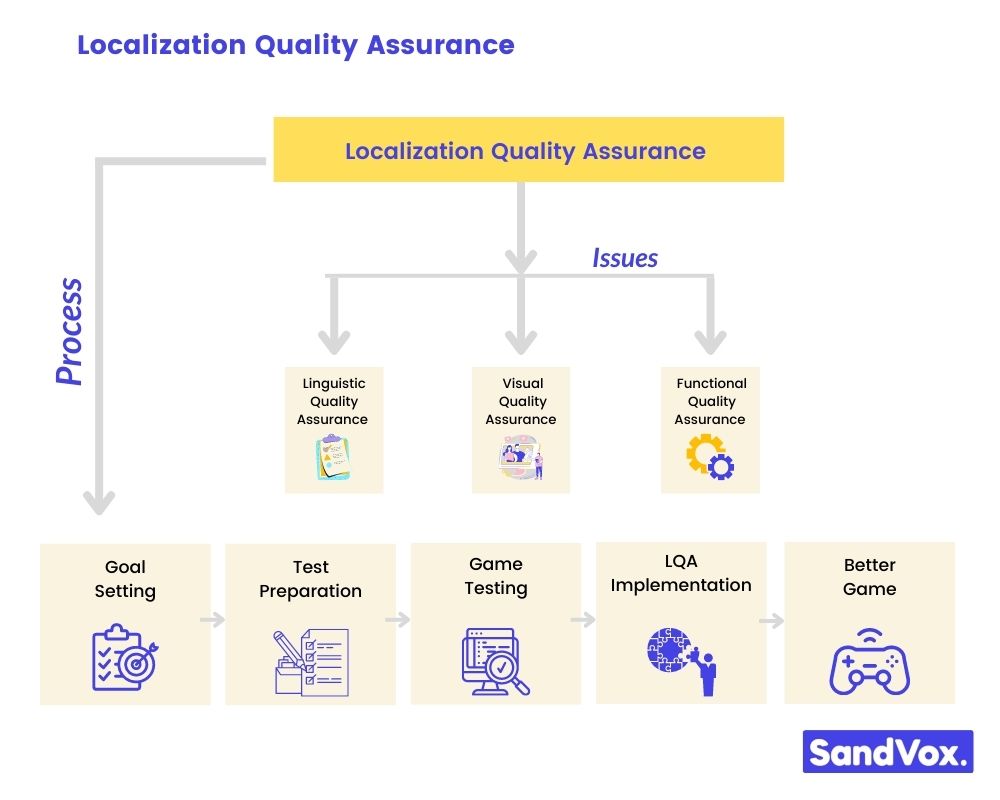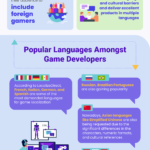Listen to the article
When expanding into new markets, localization is one of the essential processes. After all, potential gamers are more likely to play, buy or download your game if they resonate, connect, engage with your content, and fully understand your product. Gaming localization quality assurance is about making sure that your game is perfectly adapted to the new target audience.
To guarantee localization quality, you need to set a method of evaluating it. In this post, we’ll show you some LocQA best practices that will help you build a thorough QA.
But let’s start with the beginning:
What is localization quality assurance?

Like any other service, the quality of translation and adaptation to a foreign audience may vary for various reasons. That’s why you need to test your product before launching it into new markets. And here the localization qa comes into the picture, being the last stage of this process.
Basically, locQA focuses on linguistic testing and translation quality review while covering UI/UX evaluation, compliance testing, culturalization, internationalization, functional tests, and more.
Simply put, native-speaking linguists with expertise in gaming and local culture play and review your game, ensuring that there are no problems or errors – both linguistically and visually.
If the game is about to be published in multiple languages, the appropriate native professionals should test every version.
Localization quality assurance confirms that the game is localized to (all) the desired languages, all strings are translated, and no development and implementation issues are found. Plus, it makes sure that the translations have a natural flow and consistency.
Why do you need locqa for your game?
According to Newzoo’s Global Games Market Report, the worldwide gaming market is expected to generate more than $196.8 billion in revenue for 2022, with the Middle East, Africa, and Latin America driving much of this growth this year and beyond.
The number of players is forecast to grow from 2.9 billion in 2020 to 3.5 billion by 2025, with the same emerging markets driving this growth.

Given the gaming market trends, developing your game with global users in mind is a must-do, and the localization quality assurance strategy is a vital step.
And this is because game localization is essential, no matter the source language of your playing. Even if the in-game texts are in the correct language, this is not enough. The dialogues and visuals must be appropriately adapted to the new market while keeping the UX/UI functionality.
A good translation quality assurance process should minimize the number of mistakes and reveal any flaws in your game so you can fix them before publishing.
What does game localization qa include?
In games, assuring the localization quality means more than simply checking for things like grammar and spelling errors. LocQA testers consider factors such as context, user experience, and cultural nuances when testing and analyzing the gameplay.
In their qa process, a locQA tester will look for three things:
- Linguistic QA – targets mistakes in game scripts and voice-overs, such as spelling, grammar errors, and mistranslations. In the end, the linguistic QA testers suggest how to fix them or provide alternative translations;
- Visual QA – checks for any design-related issues, such as untranslated or partial translated content and graphics, truncated characters, font issues, overlong strings, UX/UI issues, and compliance checks;
- Functional QA – takes into consideration any graphic, art, or development bug that requires a code change to be fixed; most issues include broken links, performance issues, graphic, audio, and text problems, difficulties generated by the international keyboards, and AI behavior.
To have an effective localization QA, you should consider the following steps:

- Set up your goals – the LQA manager determines your needs and designs the test plan and schedule
- Pre-test preparation – game testers receive the localization brief that includes information about the game genre, previous versions (if they test updates), localization kit, style guides, and any other relevant info they need to perform the testing
- Game testing. LQA specialists play the game and assess linguistic quality while documenting the bugs and inconsistencies. They also provide screenshots, explanations of the issues, and suggestions on how to improve the game
- LQA implementation. After you receive the reviewed files, the localization manager helps you implement updates.
Localization Quality Assurance best practices
Now that you know the main locQA aspects and the basic stages involved let’s dig deeper and see how you get the most from your quality assurance process.
#1. Start early and test often
This mantra used by software developers also applies to game localization testing. The sooner you include testing as part of the localization process, the faster testers will identify bugs. You will thus avoid turning these mistakes into costly problems.
#2. Hire gamers as localization quality assurance testers as they can better understand your product
To ensure your game is ready to be launched in the specific target market, you must check it with local skilled testers. In addition, it would be great if they were also gamers. After all, who understand players better than gamers?
This way, they can evaluate every aspect of localization testing – from language and culture changes, swiping, and functionality to the interplay between translation and UI.
#3. Perform a bilingual examination as part of your localization quality assurance testing
The localization testing process should include a bilingual examination, which means comparing the original game with the localized one. Again, it’s essential that the localization qa testers fully understand your product and the target audience to ensure that the adapted gameplaying retains the intention of the original playing.
#4. Look for translation errors and consider the context
Your QA team should identify issues such as mistranslations, omissions, and inconsistencies. Also, look for typos that automated spell check features would miss by considering the context.
#5. Leverage technologies to facilitate localization testing
Using CAT tools with a translation memory feature will help improve translation accuracy and consistency over time. Also, you should create a translation glossary and store it on your localization management platform. This way, you’ll ensure that all translators use the same specific terms throughout the translated text.
#6. Use automated QA modules to improve the localization quality assurance process
Many CAT tools offer built-in modules that support the QA process. They can detect basic translation mistakes, such as grammar, spelling, formatting, punctuation marks, inconsistencies, and more. Some of them can also generate quality assurance reports so the linguists can review and fix those issues that require their attention and expertise.
#7. Evaluate customer experience
After you’ve covered and fixed all the issues related to spelling and grammar, layouts, formatting, and cultural factors, it’s time to move on to customer experience – the final testing stage.
This part of LQA helps you understand how players use your game and how they connect and engage with your brand. It works as an extra layer of quality assurance, detecting additional issues and verifying that the changes made by LQA teams haven’t created new problems.
#8. Create your Localization AQ report
At the end of the LQA testing phase, you need to draw conclusions and have a quality assurance report. This brings together the findings of linguistic professionals, cultural analysts, playtesters, coders, and user experience experts.
Make sure the report is comprehensive but precise. Keep in your mind that this report is useful not just in the short term but also in the long term. So, make it clear and precise, easy to read, and accessible to future locqa teams, and include any changes that have been made or need to be made, as well as the evidence to back them up.
Bonus point: Checklist for localization testing
#1 Style guide: Set from the very beginning the tone of voice and the language style used in your game
#2 Glossaries: What is the key terminology that needs to be translated?
#3 Product specification: What are the requirements?
#4 Languages and locations: In what languages and for which market(s) needs your game to be tested?
# 5: Product platform: on which platform will the testing be performed (mobile, desktop, or consoles)?
# 6: Functional/UI testing should consider
- No overlapping or truncation of texts
- Font size is correct across the whole game
- The product layout is consistent with its source language version
- Game functionality is working even if the product is not in the original language
#7: Location-related testing scope
- The content of your game is correct based on the region’s specificity
- Date, time, decimal number, currencies, and temperature formats follow language/region standards
- Colors are appropriate according to local customs.
- Flags and country names are correct
- Event-based marketing is triggered in the correct season and shows the right context according to the local customs
# 8: Linguistic testing pays attention to
- Grammar, spelling, and punctuation
- Unnatural translation and idiomatic testing (checking if the game tone is in line with Style guidelines)
- Translation consistency across the product
- RTL (right to left for Arabic and Urdu Language) format
- Improvement suggestions from testers to the product
# 9: Monitor your KPIs
- Measure your user growth, analyze existing users, and linguistic-related complaints before and after locqa testing
Final words
When intending to expand into new markets, localization is a must. If you get it right, you’ll open doors for millions of new players worldwide and massively improve your revenue potential.
But accurate translation and cultural sensitivity are the cornerstones of expanding into foreign markets. That’s why you need to make sure your game is perfectly adapted to the new audience and compatible with local platforms and browsers. In addition, attention to detail will show your players that your company cares about their needs.
In this context, localization quality assurance is an important element in the process of adapting to foreign markets. Working with an experienced localization company with proven experience can help you avoid embarrassing and costly misunderstandings.






